Brief
 }
}
How will the coronavirus crisis affect the private equity industry? The only honest answer is that nobody really knows.
As a healthcare crisis, it is unprecedented in its global sweep and impact. As an economic event, it raises many unknowns about how the sudden demand shock and existential dread will affect business activity and consumer behavior—especially if the lockdown persists for an extended time.

Macro Surveillance Platform
For more detail on the business implications of coronavirus from Bain’s Macro Trends Group, log on to the Macro Surveillance Platform. Learn more about the platform >
Yet a close look at the impact of previous economic shocks can provide some clues as to how PE funds and their limited partners (LPs) will behave in a period of rapid contraction. With that in mind, we broke down how the 2008–09 global financial crisis affected industry activity and then looked at what’s different this time around that might lead to different outcomes for dealmaking, exits, fund-raising and returns.
There’s little doubt that the PE industry will quickly retreat from a remarkable decade of growth and superior performance. But history and current conditions suggest that funds won’t sit still for long.
Investments
Dealmaking fell off sharply when the global financial crisis hit in 2008, and this crisis should also trigger a substantial contraction (see Figure 1). In the wake of the sudden and unpredictable demand shock, general partners (GPs) have shifted to triage mode, looking to diagnose challenges and stabilize their portfolios. Sellers, meanwhile, are reluctant to part with assets given the steep drop in equity values. The combination of extreme market volatility and uncertainty quickly leads to a mismatch in buyer and seller expectations. That is already disrupting transactions.
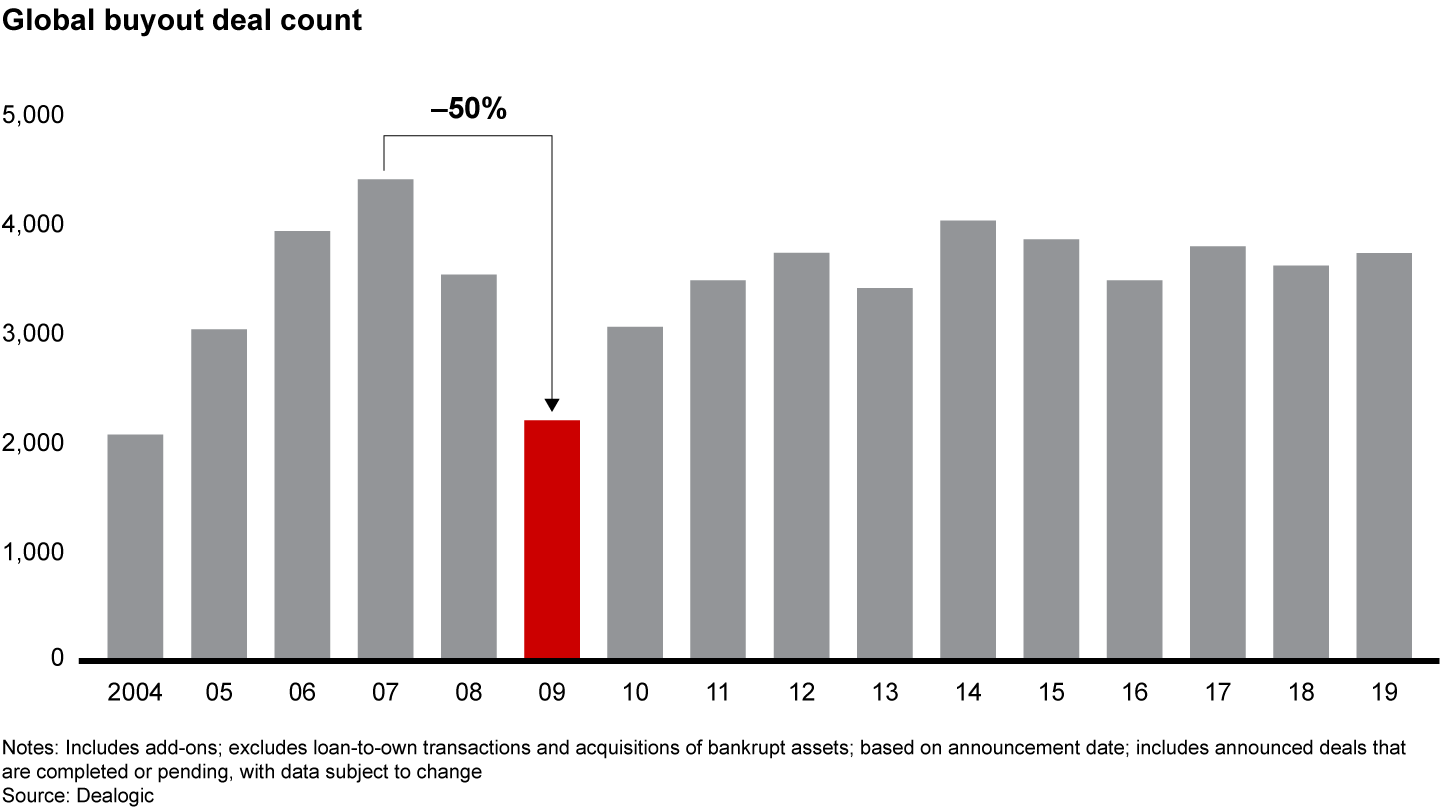

Credit markets, meanwhile, have tightened up but haven’t frozen completely as they did during the global financial crisis, when leveraged loan issuance sank by almost 80%. Still, high-yield lending was already in retreat before the crisis hit and has skidded since. Banks will put lending for new deals on hold as they focus on working with existing borrowers to avoid default.
It will also take time for lenders to work through how to assess risk today. Scrutiny during underwriting will increase dramatically as they work out how much to lend and at what price. Indeed, we can expect to see a reversal of the easy money environment of the last several years. In 2019, around three-quarters of all deals were leveraged at more than six times earnings before interest, taxes, depreciation and amortization (see Figure 2). As those multiples compress, buyers will have to contribute more equity to get deals done in the near term.
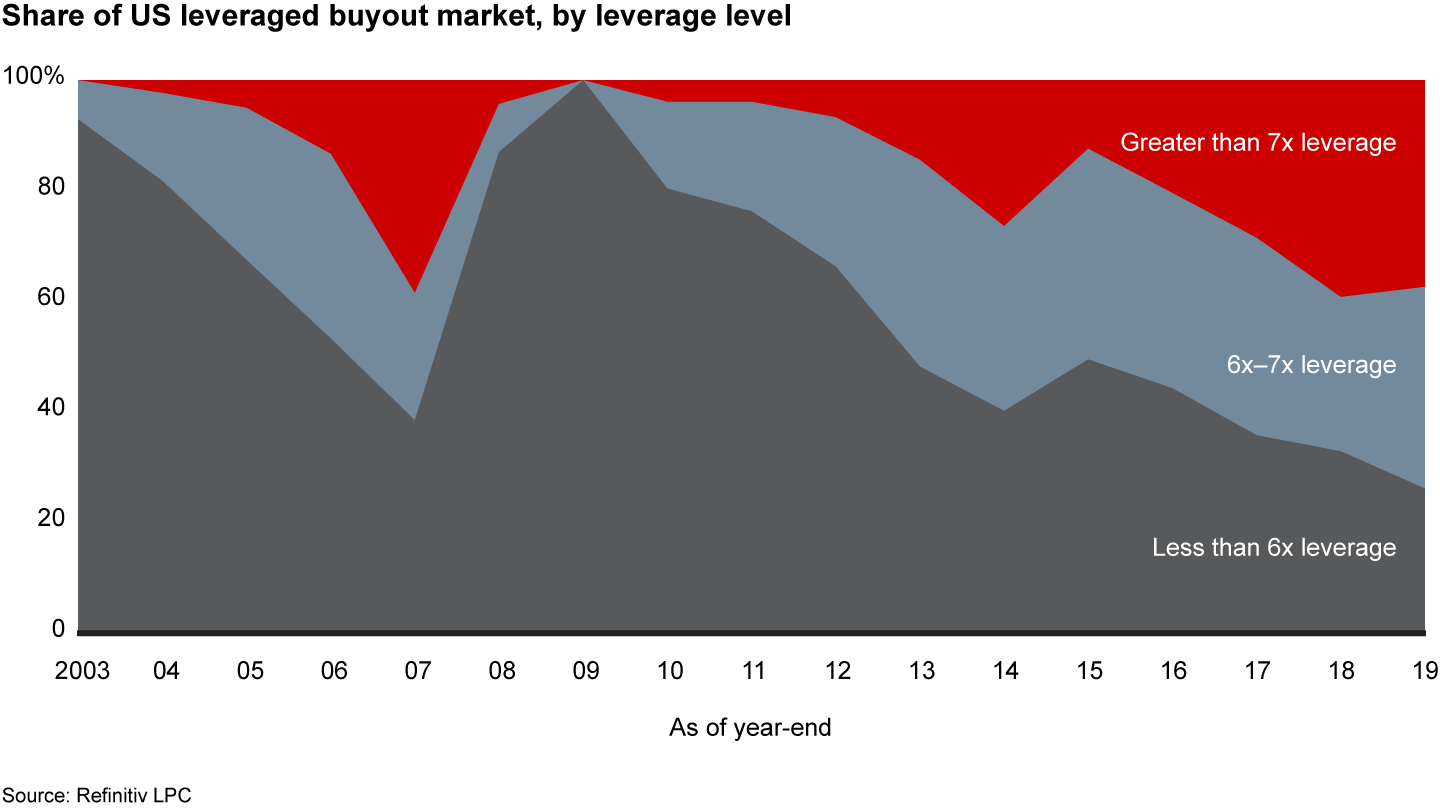

While these factors suggest that dealmaking and lending activity will slow in the months ahead, there are some significant differences in the current market that could limit the downdraft in activity.
First, PE funds have a record $2.5 trillion in uncalled capital—more than $800 billion for buyouts alone—and are on the clock to spend it. This mountain of dry powder will force GPs to stay on the lookout for deals, especially as valuations (which have also been setting new records) retreat amid the economic turmoil. Count on distressed debt investors to lead the way.
The second factor is that private lenders could fill some of the gap left by banks as they back away from the buyout market. Private debt funds have emerged since the global financial crisis as a major force in the market and have more than three times the assets under management they had in 2008, with substantial capital waiting to be put to work. They might provide financing for new deals. They will also help provide liquidity to businesses that are experiencing short-term dislocations. They shouldn’t be confused with banks, however. The firms with the largest direct lending funds also have extensive distressed debt and special situations capabilities. They will seek out opportunities to provide bridge financing with an attractive risk/return profile, and some will engage in “loan-to-own” investing, which seeks control over companies in distress. As the big banks demonstrated during the global financial crisis, they are generally not inclined to take the keys from distressed borrowers.
One other note on dealmaking: Competition for attractive targets will likely wane, to private equity’s advantage. With the public markets depressed and potential corporate buyers holding onto their cash, PE funds are well positioned to be the buyer for any asset that does come up for sale.
Exits
Exits will inevitably drop, and holding periods for some assets will extend, as sellers sit tight and wait for the markets to recover. But activity may not fall off as steeply as it did in 2008 and 2009. At that time, the majority of deals in PE portfolios were around two years old, meaning most weren’t mature enough to sell anyway.
Now, the industry is coming off many consecutive years of strong dealmaking, and GPs are sitting on assets that they would be expected to sell soon in a normal market. They won’t exit if the price isn’t right (unless they have to). But there is reason to believe that as soon as market conditions improve, exits could rebound faster than we saw coming out of the global financial crisis.
Fund-raising
For institutional investors that weathered the global financial crisis, the current shock is unlikely to shake an underlying confidence in private equity. Since then, investors have increased their PE allocations with the expectation that the asset class will continue to deliver outsize returns vs. public markets over the long run. LPs are not signaling a reversal in that trend. And having learned a lesson about the importance of vintage-year diversification through a downturn, they are more inclined to maintain a steady pace of fund commitments amid the current crisis. LPs that backed away from private equity in the wake of the global meltdown regretted it when the industry rebounded during the subsequent recovery. These factors suggest that the decline in fund-raising this time around might be less severe than in 2008–09, when the global total dropped more than 50%.
At the same time, several structural factors could limit the amount of new capital flowing into PE funds for a period of time.
The first is the denominator effect, which throws an LP’s current PE allocation out of whack when public equities rapidly fall in value. That’s because the value of private equity in an investor's portfolio (the numerator) does not change immediately when the public market declines. Rather, the overall portfolio (the denominator) shrinks due to the fall in public valuations, magnifying the relative share of the PE allocation. The denominator effect tends to be short lived, as PE funds mark their portfolios to market over a period of quarters (see the Returns section below). But for LPs bound by a set PE allocation, a sharp denominator effect can inhibit new investment, at least temporarily.
A bigger limiting factor is cash flow management. Industry capital calls will once again exceed distributions in the near term as the drop in exit activity slows payouts to LPs (see Figure 3). GPs, meanwhile, will step up draws to help shore up their portfolio companies. New investments have slowed, but not stopped, and for funds such as distressed debt and special situations, the pace of capital calls will increase. The proliferation of subscription lines of credit over the past decade could also intensify the pressure on LP cash flows if GPs seek to pay down these lines.
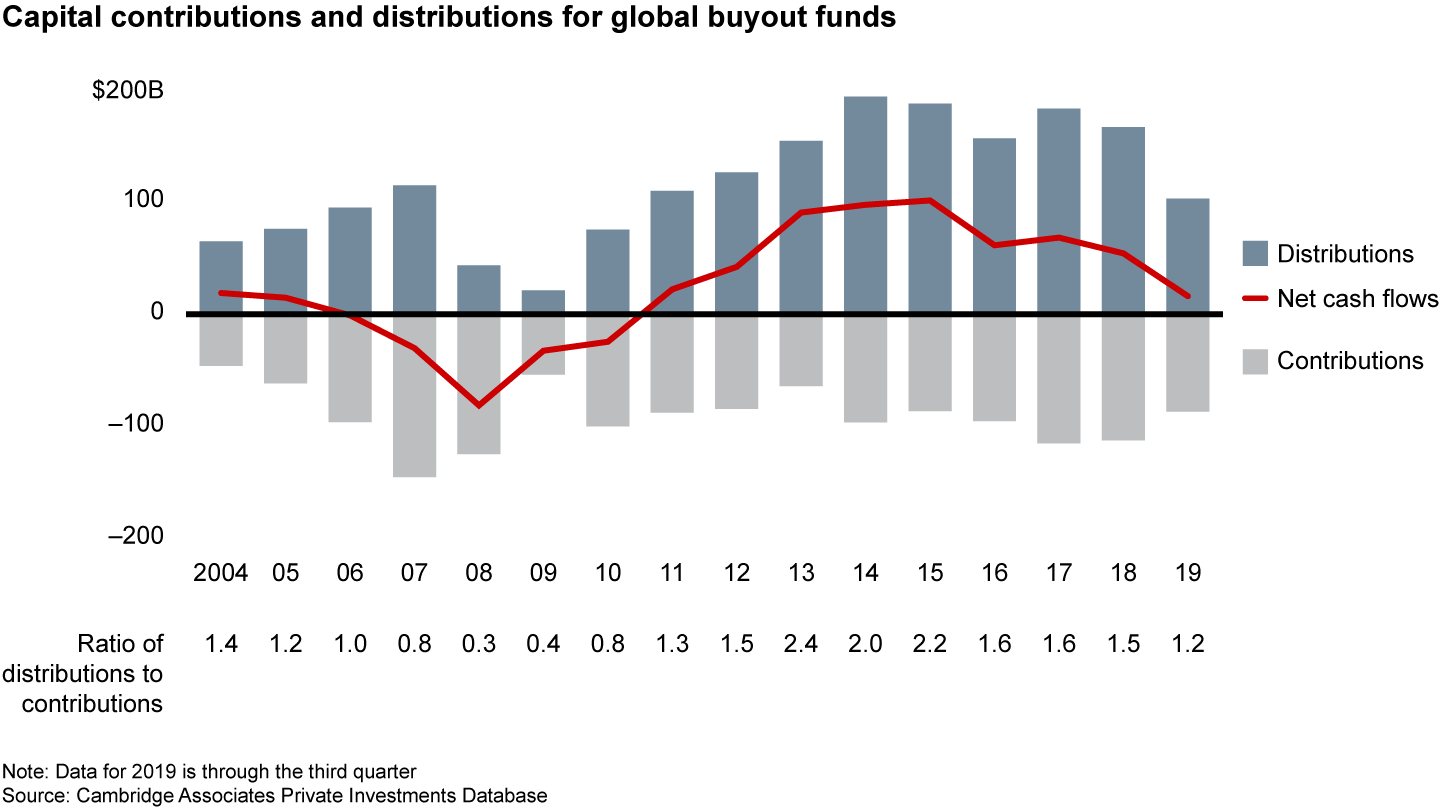

These factors will inevitably make it more difficult for GPs to meet their fund-raising targets. Funds on average have found it easy to bust through their original targets in recent years as LPs flocked to the industry. But if history is any guide, that pattern will reverse itself in the near term and LPs will become significantly more choosy about where they direct a reduced flow of capital.
Returns
Expect returns to take a hit in the short term as funds mark down their portfolios in step with the drop in public valuations (see Figure 4). The impact will not be known for several quarters, as mark-to-market moves lag public equities and PE funds report quarterly. But GPs are likely to drop valuations steeply to give their investors the bad news only once, rather than making valuation haircuts quarter after quarter.
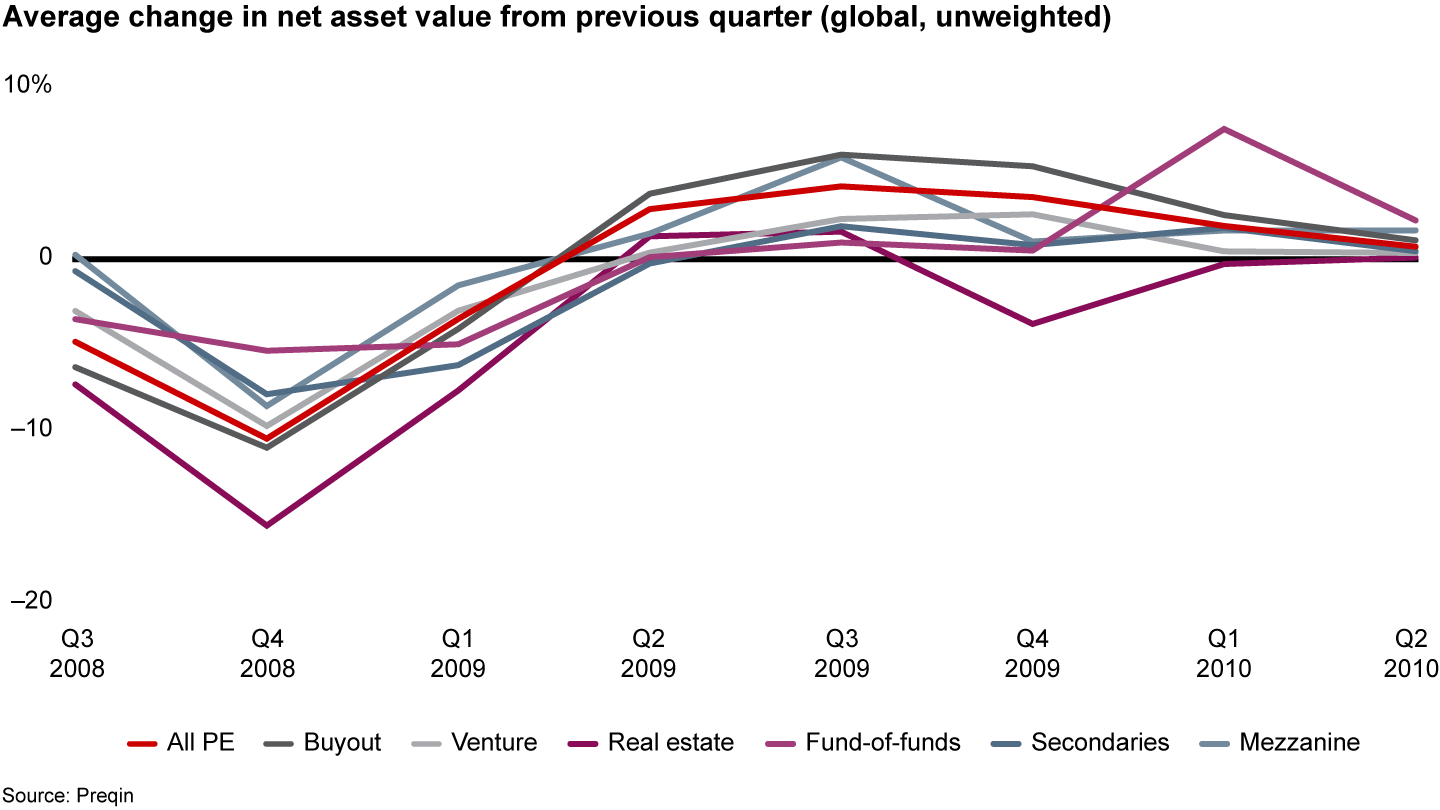

Given the uncertainty surrounding the Covid-19 crisis, it is impossible to gauge the longer-term impact on industry performance. Much will depend on the duration of the lockdown and the shape of the subsequent recovery. High-valuation deals done before the downturn may ultimately suffer as company performance comes under pressure. History also shows that the superior returns from investments made during the crisis and coming out of it can counteract lower returns from precrisis investments (see Figure 5).
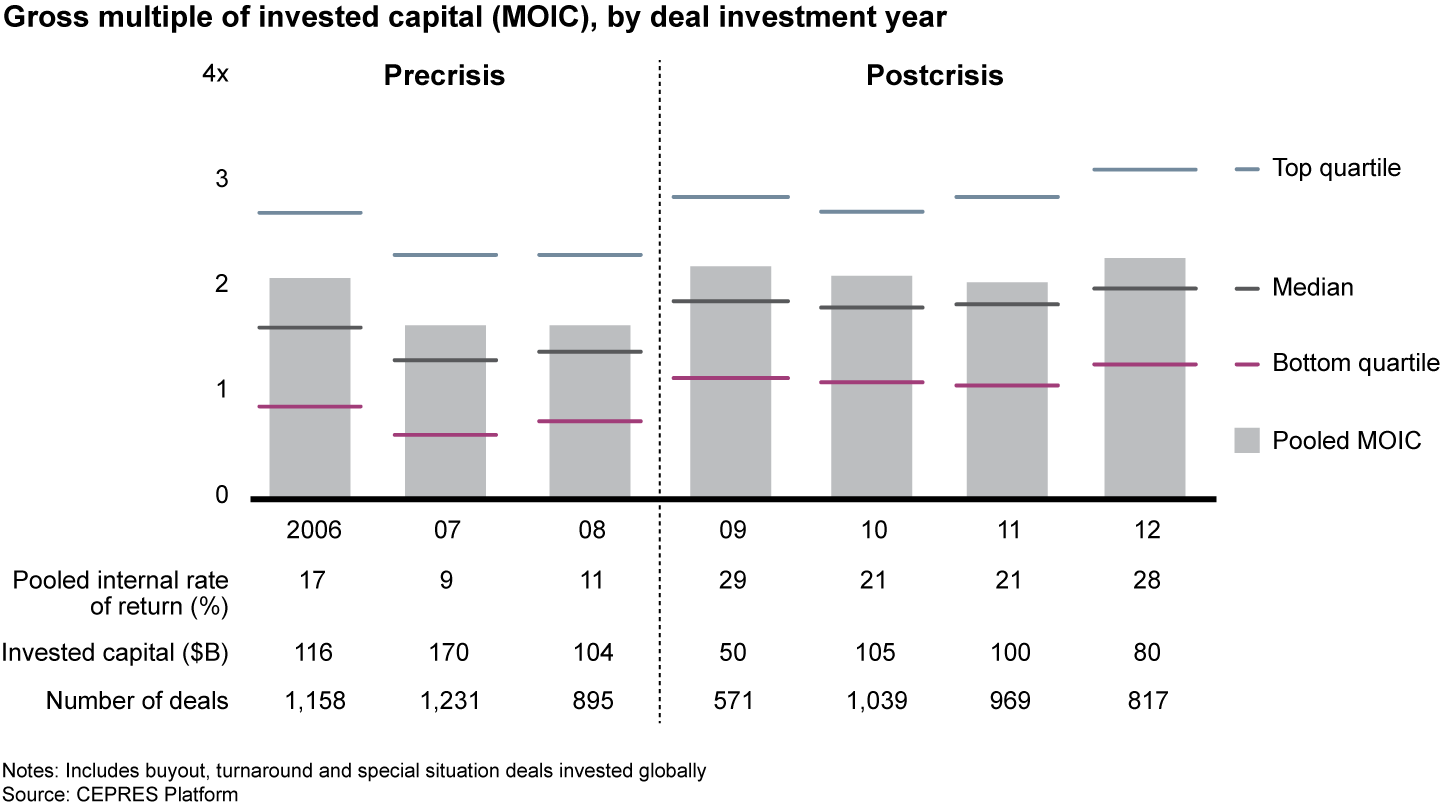

It is worth noting that the macro forces this time around could be very different from those in play after the global financial crisis. Investments coming out of that downturn benefited from a wave of market beta in the form of record-low interest rates, steadily increasing multiples and GDP growth. The initial impact of the Covid-19 crisis will likely be deflationary, but once the immediate crisis abates, government actions and supply-chain impairment could trigger inflation, putting upward pressure on interest rates. Higher borrowing costs would limit debt levels, which, in turn, would lead to a more challenging recovery for private equity investors.
Some early thoughts on how the industry will adjust
It’s obviously too soon to draw many conclusions about the long-term impacts of the Covid-19 crisis, but the funds most prepared to weather this crisis—and the next one—will share some key characteristics.
- Sector expertise will become more critical than ever. Turbulence reshuffles the deck, so understanding what will differentiate the winners from the losers in any subsector is imperative right now. The world post-Covid for some industries will be forever changed (lasting impact on consumer demand, for instance, or acceleration/deceleration in industry penetration curves). Funds will need sector expertise to place smart bets on how the future will play out.
- The scope of due diligence will change. No one saw this pandemic coming, but it highlights the importance of modeling a range of scenarios in due diligence and preparing for the worst. Factoring in foreseeable but unpredictable disruption will become a standard part of due diligence in the future. A good example highlighted by the current crisis is the importance of gauging a target’s resilience to supply-chain weakening. Being able to model a temporary or longer-term unraveling of global markets will be a critical part of determining a company’s ability to win.
- Portfolio value creation 3.0? PE firms went from having scant value-creation muscle before the global financial crisis (version 0.0) to rapid hiring of expertise postcrisis (1.0). Over the past few years, they have been rethinking what has worked, or not, in terms of value creation and making adjustments (2.0). This crisis will expose just how effective portfolio operations have been and will prod GPs to reassess and make critical changes once again (3.0).
After a period of extraordinary performance, the PE industry is already bracing for a difficult time. But private equity’s advantage is that it can actively manage portfolio companies to diagnose and mitigate problems in real time. In the wake of the last crisis, firms have built new capabilities and learned important lessons about how to navigate a downturn. Successfully managing what’s to come will likely involve reaching out to a broad ecosystem of resources to help weather the storm—and prepare for the next wave of prosperity.

Coronavirus
The global Covid-19 pandemic has extracted a terrible human toll and spurred sweeping changes in the world economy. Across industries, executives have begun reassessing their strategies and repositioning their companies to thrive now and in the world beyond coronavirus.
Hugh MacArthur is a Bain & Company partner and head of the firm’s Global Private Equity practice. Graham Elton is a Bain partner based in London and a member of the Private Equity practice. Brenda Rainey, based in Denver, is a senior director of the Private Equity practice.